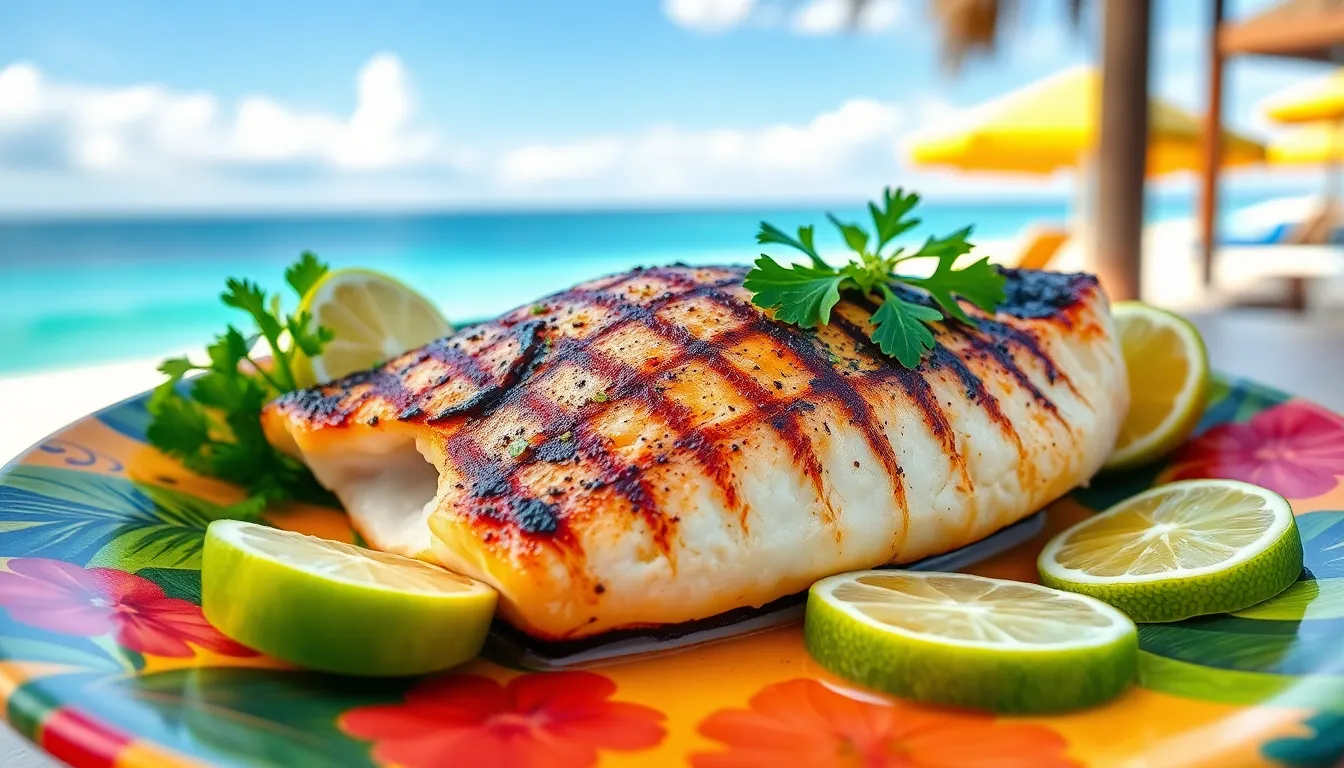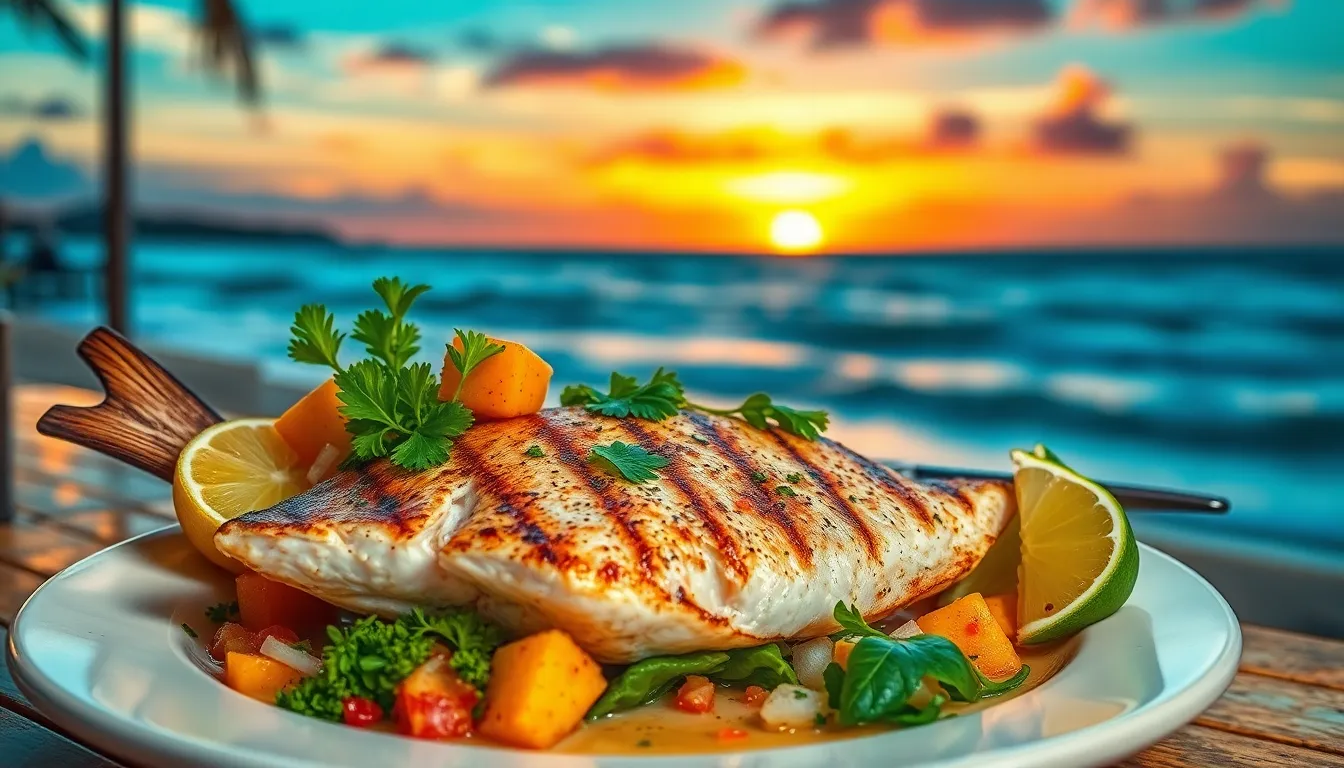Mahi mahi, often dubbed the “dolphin fish” (but don’t worry, it’s not Flipper on your plate), is a culinary gem that’s turning heads in kitchens around the world. Imagine biting into a piece of fish that’s as vibrant as a tropical sunset and as flavorful as a beach vacation. This isn’t just any fish; it’s the superstar of the sea, boasting a taste that’s buttery, slightly sweet, and oh-so-delicious.
Table of Contents
ToggleOverview of Mahi
Mahi mahi, renowned for its vibrant color and texture, offers a unique culinary experience. This fish features a firm, flaky flesh that stands up well to various cooking methods. Grilling, baking, and broiling are popular options, enhancing its natural flavors.
Its taste is a harmonious blend of buttery richness and subtle sweetness. Some describe it as similar to swordfish or tuna, with a slightly milder profile. This balance makes mahi a versatile choice for various cuisines, pairing well with tropical fruits and zesty marinades.
When cooked, mahi retains moisture and tenderness, making it enjoyable for many palates. The texture becomes succulent, and the taste offers a hint of the sea, appealing to seafood lovers. Expert chefs often recommend simple seasonings to complement its natural flavor rather than overpowering it.
Culinary uses extend beyond traditional dishes; chefs incorporate mahi into tacos, salads, and sandwiches. Each preparation method highlights its delicious qualities, contributing to its popularity in restaurants and home kitchens alike. People appreciate mahi for its versatility, whether served with fresh vegetables or in a rich sauce.
Different regions also present mahi in various styles, enriching its appeal across cultures. From tropical ceviche to spicy grilled preparations, the diversity in presentation adds to the overall enjoyment. Enthusiasts of seafood find mahi mahi an exciting option that brings a taste of the ocean to the table.
Flavor Profile of Mahi

Mahi presents a unique taste experience, characterized by its appealing texture and distinct flavor attributes.
Texture
Mahi boasts a firm and flaky texture that enhances its culinary versatility. The flesh retains moisture well during cooking, ensuring a succulent bite. Chefs often prefer mahi for its ability to hold up to various cooking techniques. Grilling mahi results in a slightly crispy exterior while keeping the inside tender. Both the robust texture and moisture content make it a popular choice for seafood dishes.
Taste Characteristics
Mahi’s flavor profile combines buttery richness with subtle sweetness. The taste leans towards a mild ocean flavor without overpowering the palate. When cooked, the fish develops a sweetness that complements various seasonings. Its inherent flavors pair wonderfully with tropical fruits, herbs, and zesty marinades. Diverse cooking methods highlight different aspects of mahi’s taste, making it suitable for numerous culinary styles. Each preparation reveals new layers of flavor, appealing to a wide range of preferences.
Cooking Methods for Mahi
Mahi can be prepared using various cooking methods, each bringing out unique flavors and textures.
Grilling
Grilling mahi creates a delightful smoky flavor while preserving its moist, flaky texture. Chefs prefer marinating the fish in citrus-based blends to enhance its natural sweetness. Grilled mahi often pairs perfectly with fresh herbs or a squeeze of lime juice. Cook over medium-high heat for approximately six to eight minutes per side, allowing beautiful grill marks to form. The firm flesh makes this fish ideal for skewers, enabling easy handling without falling apart. Mahi tacos topped with grilled pineapple salsa exemplify how grilling elevates this fish’s culinary experience.
Baking
Baking mahi is simple and enhances its buttery richness. When using a moderate oven temperature of 375°F, cooks can season the fish with different herbs, garlic, and lemon juice. A cooking time of 20 to 25 minutes delivers tender, flaky results. Foil packets work especially well, sealing in moisture and flavor. Adding vegetables like asparagus or bell peppers alongside the mahi creates a complete meal with vibrant colors. Baked mahi can serve as a healthy, flavorful option for those seeking convenient weeknight dinners.
Pairing Suggestions
Mahi mahi pairs beautifully with a variety of accompaniments. The right side dishes enhance the fish’s unique flavor and texture.
Side Dishes
Fresh salads work well alongside mahi mahi, especially those featuring citrus elements like grapefruit or orange. Tropical grains, such as coconut rice or quinoa with mango, bring a sweet contrast to the fish. Grilled vegetables add a smoky touch, balancing mahi’s richness. Roasted potatoes or sweet potatoes provide heartiness, making for a satisfying meal. In addition, coleslaw with a tangy dressing can introduce crunch and freshness, enhancing the overall dining experience.
Sauces and Spices
Various sauces and spices elevate mahi mahi’s natural sweetness. A lime and cilantro sauce offers bright acidity that complements the fish’s flavor. Consider a mango salsa for a tropical twist, blending sweetness with a touch of heat. Garlic butter drizzled over mahi preserves its buttery notes while adding richness. Spices such as cumin, paprika, or chili powder can create a delightful crust when grilled or baked. Each of these options brings out different dimensions of the fish, enriching the dining experience.
Mahi mahi stands out as a delightful seafood option that captivates with its unique flavor and versatile culinary applications. Its buttery and slightly sweet taste combined with a firm yet flaky texture makes it a favorite among chefs and home cooks alike. Whether grilled, baked, or incorporated into vibrant dishes, mahi mahi consistently delivers a satisfying dining experience.
With its ability to pair beautifully with tropical fruits and zesty marinades, this fish brings a taste of the ocean to any meal. Exploring the various cooking methods and pairing options can elevate mahi’s natural qualities, ensuring it remains a beloved choice for seafood enthusiasts.

